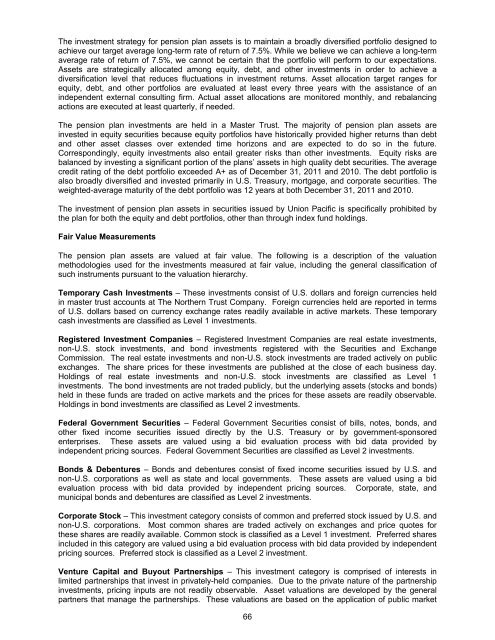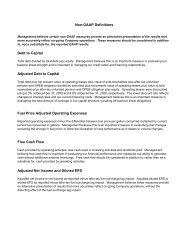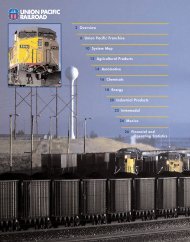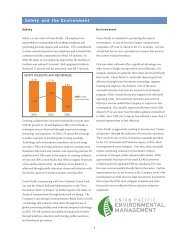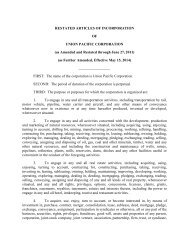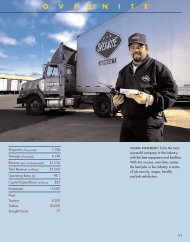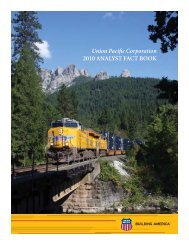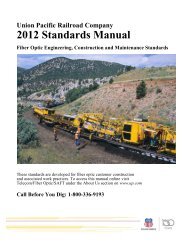Form 10-K - Union Pacific
Form 10-K - Union Pacific
Form 10-K - Union Pacific
Create successful ePaper yourself
Turn your PDF publications into a flip-book with our unique Google optimized e-Paper software.
The investment strategy for pension plan assets is to maintain a broadly diversified portfolio designed to<br />
achieve our target average long-term rate of return of 7.5%. While we believe we can achieve a long-term<br />
average rate of return of 7.5%, we cannot be certain that the portfolio will perform to our expectations.<br />
Assets are strategically allocated among equity, debt, and other investments in order to achieve a<br />
diversification level that reduces fluctuations in investment returns. Asset allocation target ranges for<br />
equity, debt, and other portfolios are evaluated at least every three years with the assistance of an<br />
independent external consulting firm. Actual asset allocations are monitored monthly, and rebalancing<br />
actions are executed at least quarterly, if needed.<br />
The pension plan investments are held in a Master Trust. The majority of pension plan assets are<br />
invested in equity securities because equity portfolios have historically provided higher returns than debt<br />
and other asset classes over extended time horizons and are expected to do so in the future.<br />
Correspondingly, equity investments also entail greater risks than other investments. Equity risks are<br />
balanced by investing a significant portion of the plans’ assets in high quality debt securities. The average<br />
credit rating of the debt portfolio exceeded A+ as of December 31, 2011 and 20<strong>10</strong>. The debt portfolio is<br />
also broadly diversified and invested primarily in U.S. Treasury, mortgage, and corporate securities. The<br />
weighted-average maturity of the debt portfolio was 12 years at both December 31, 2011 and 20<strong>10</strong>.<br />
The investment of pension plan assets in securities issued by <strong>Union</strong> <strong>Pacific</strong> is specifically prohibited by<br />
the plan for both the equity and debt portfolios, other than through index fund holdings.<br />
Fair Value Measurements<br />
The pension plan assets are valued at fair value. The following is a description of the valuation<br />
methodologies used for the investments measured at fair value, including the general classification of<br />
such instruments pursuant to the valuation hierarchy.<br />
Temporary Cash Investments – These investments consist of U.S. dollars and foreign currencies held<br />
in master trust accounts at The Northern Trust Company. Foreign currencies held are reported in terms<br />
of U.S. dollars based on currency exchange rates readily available in active markets. These temporary<br />
cash investments are classified as Level 1 investments.<br />
Registered Investment Companies – Registered Investment Companies are real estate investments,<br />
non-U.S. stock investments, and bond investments registered with the Securities and Exchange<br />
Commission. The real estate investments and non-U.S. stock investments are traded actively on public<br />
exchanges. The share prices for these investments are published at the close of each business day.<br />
Holdings of real estate investments and non-U.S. stock investments are classified as Level 1<br />
investments. The bond investments are not traded publicly, but the underlying assets (stocks and bonds)<br />
held in these funds are traded on active markets and the prices for these assets are readily observable.<br />
Holdings in bond investments are classified as Level 2 investments.<br />
Federal Government Securities – Federal Government Securities consist of bills, notes, bonds, and<br />
other fixed income securities issued directly by the U.S. Treasury or by government-sponsored<br />
enterprises. These assets are valued using a bid evaluation process with bid data provided by<br />
independent pricing sources. Federal Government Securities are classified as Level 2 investments.<br />
Bonds & Debentures – Bonds and debentures consist of fixed income securities issued by U.S. and<br />
non-U.S. corporations as well as state and local governments. These assets are valued using a bid<br />
evaluation process with bid data provided by independent pricing sources. Corporate, state, and<br />
municipal bonds and debentures are classified as Level 2 investments.<br />
Corporate Stock – This investment category consists of common and preferred stock issued by U.S. and<br />
non-U.S. corporations. Most common shares are traded actively on exchanges and price quotes for<br />
these shares are readily available. Common stock is classified as a Level 1 investment. Preferred shares<br />
included in this category are valued using a bid evaluation process with bid data provided by independent<br />
pricing sources. Preferred stock is classified as a Level 2 investment.<br />
Venture Capital and Buyout Partnerships – This investment category is comprised of interests in<br />
limited partnerships that invest in privately-held companies. Due to the private nature of the partnership<br />
investments, pricing inputs are not readily observable. Asset valuations are developed by the general<br />
partners that manage the partnerships. These valuations are based on the application of public market<br />
66


